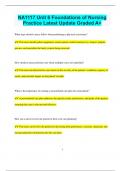NA1117 Unit 6 Foundations of Nursing
Practice Latest Update Graded A+
What steps should a nurse follow when performing a physical assessment?
✔✔ The nurse should gather equipment, ensure patient comfort and privacy, inspect, palpate,
percuss, and auscultate the body systems being assessed.
How should a nurse prioritize care when multiple issues are identified?
✔✔ The nurse should prioritize care based on the severity of the patient’s condition, urgency of
needs, and potential impact on the patient’s health.
What is the importance of creating a personalized care plan for each patient?
✔✔ A personalized care plan addresses the specific needs, preferences, and goals of the patient,
ensuring that care is relevant and effective.
How can a nurse involve the patient in their own care planning?
✔✔ The nurse can involve the patient by discussing their preferences, concerns, and goals, and
incorporating this information into the care plan.
1
,What factors should be considered when evaluating the effectiveness of a care intervention?
✔✔ Factors include whether the intervention achieved the desired outcomes, any changes in the
patient’s condition, and patient feedback on the intervention.
How does the nursing process support continuity of care?
✔✔ The nursing process supports continuity of care by providing a structured approach to
assessing, planning, implementing, and evaluating care, ensuring consistent and coordinated
care.
What is the role of critical thinking in the nursing process?
✔✔ Critical thinking helps the nurse analyze data, make informed decisions, and solve problems
effectively, enhancing the quality of patient care.
How should a nurse document a patient’s response to treatment?
✔✔ The nurse should document the patient’s response in detail, including any changes in
condition, effectiveness of the treatment, and any side effects or issues encountered.
What strategies can be used to manage a patient’s pain effectively?
2
,✔✔ Strategies include assessing pain levels regularly, using appropriate pain relief measures,
and evaluating the effectiveness of pain management interventions.
How does collaboration with other healthcare professionals enhance patient care?
✔✔ Collaboration allows for comprehensive care by integrating diverse expertise, improving
communication, and ensuring that all aspects of the patient’s health are addressed.
What are the key elements to include in a discharge plan for a patient?
✔✔ Key elements include patient education, follow-up appointments, instructions for home care,
medication management, and contact information for support services.
How should a nurse approach cultural differences in patient care?
✔✔ The nurse should respect and acknowledge cultural differences, provide culturally sensitive
care, and involve patients in their care plan in a way that aligns with their cultural beliefs.
What is the significance of setting short-term and long-term goals in patient care?
✔✔ Short-term goals address immediate needs, while long-term goals focus on overall health
improvement, helping guide the patient’s progress and care planning.
3
, How can a nurse assess for signs of infection during a physical examination?
✔✔ The nurse should look for signs such as redness, swelling, warmth, pain, and discharge at
the site, as well as systemic symptoms like fever.
What considerations should be made when planning care for a patient with chronic illness?
✔✔ Considerations include managing ongoing symptoms, coordinating with other healthcare
providers, providing education on disease management, and supporting the patient’s quality of
life.
What is the primary purpose of the nursing process?
✔✔ The primary purpose is to assess, diagnose, plan, implement, and evaluate patient care.
What is the main focus during the assessment phase of the nursing process?
✔✔ The main focus is on collecting and analyzing comprehensive data about the patient's health
status.
How can a nurse ensure effective communication during patient interactions?
✔✔ A nurse can ensure effective communication by using clear, simple language and confirming
that the patient understands the information provided.
4




